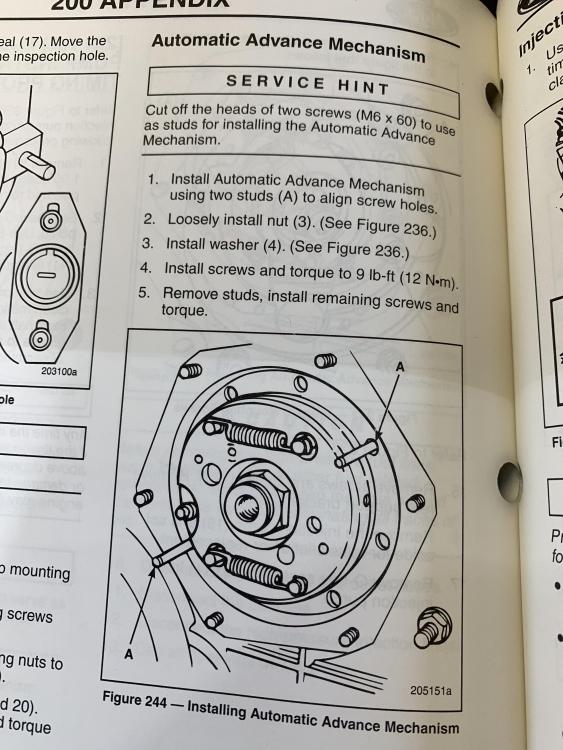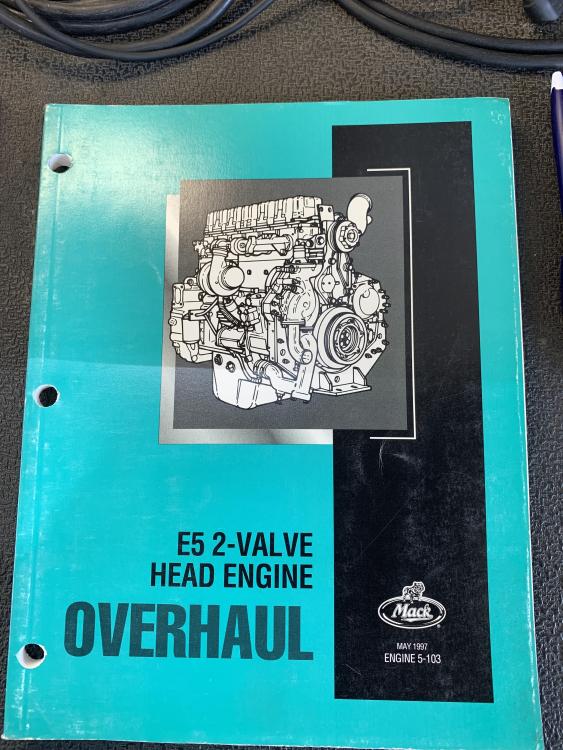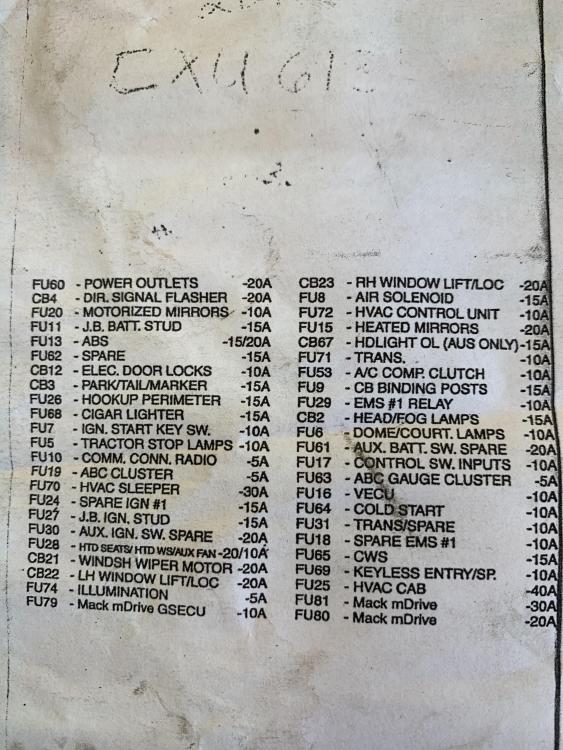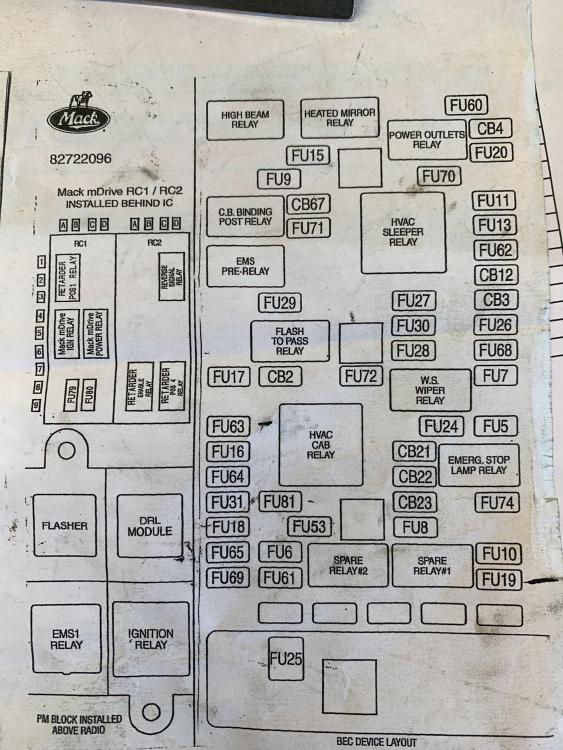
Mackpro
-
Posts
2,934 -
Joined
-
Last visited
-
Days Won
10
Content Type
Profiles
Forums
Gallery
Events
Blogs
BMT Wiki
Collections
Store
Posts posted by Mackpro
-
-
What settings you needing info on ? Robert Bosch pump I assume?
-
2 hours ago, Tonywham said:
Thanks for the reply. I was thinking I might be having problems with the fan clutch not engaging at a lower temp. Is the clutch controlled by a sensor or computer? Or possibly a faulty thermostat?
Engine ecm looks at coolant temp and AC high pressure switch and possibly other sensors to determine if the fan needs to be engaged. Start the engine up cold . A/C off . Rev it to about 1200 and listen for the fan to slow down. Then unplug the Green pressure switch on the AC line by the radiator. The fan clutch should speed up gradually. You should be able to feel the air flow through condenser. We have to pull the after coolers off ours every 2 years to wash the radiators out. A fault code on the oil thermostat solinoid or the piston cooling oil solinoid can cause fan issues as they are on the same power circuit on most truck pre-common rail
-
 2
2
-
-
On the GR , PI and AN model trucks with the new dash you have to use tech tool. Everything is controlled by the LCM light control module.
-
The ambient air temp sensor is mounted in the upper right areas of the aftercooler and the AC condenser right below it. When you sitting still and fan clutch not engaged, the heat off the condenser, aftercooler and radiator cause the ambient air temp sensor to read higher than the actual outside air. Once the fan kicks in or you idle the engine up , the fan pulls the actual “cooler” air past the sensor and the readings go down.
-
 1
1
-
-
Can you figure out what brand steering gear you have ? I have several manuals for the Sheppards and the old TRW /Ross HFB64 and 70 gear boxes. The seal you are locking for they refer it as the sector shaft seals
-
 1
1
-
-
If you can find out what the actual fault code number was let me know . We only have MP8’s here but had a couple of 2020 year model trucks just randomly loose power and set code for low fuel rail pressure or something to that effect. Ended up the dealership putting 6 new injectors in and it solved the problem.
-
-
-
I have a engine overhaul manual on the E5 somewhere. Back at the dealership, there was a customer wanting to buy 2 RD’s but said our quote was to high and he could get them much cheaper at another dealership. Well he bought 2 new RD’s and brought them to us for low power complaints with in a month. You guessed it E5. We were like “ What the hell is a Midliner engine doing in there “.
-
First , drive the truck . Even if you repair/replace sensor and clear the code , the code will come back till you drive it and it see a wheel speed reading. Fuse 13 and 14 feed 12 volts to the ABS ECM. Best I remember , Not all trucks need both fuses. Road tractors CHN/CXN have ESP enhanced stability protection that requires both fuses. CV, MR and LE usually don’t have the ESP and don’t need both fuses. The J1939 yellow and green twisted data link wires should have around 2.5 volts plus or minus .5 volts. If you had any power supply problems you would have more than a wheel speed code. If test drive does not clear the code. Jack up the problem tire off the ground. Unplug the sensor and attach a volt meter to the 2 wire harness end of the sensor. Set the the volt meter to AC voltage. Spin the tire and watch meter. The faster you spin the tire the higher the voltage should be. Best I remember 2.5 volts at 50 rpm
-
3 minutes ago, 70mackMB said:
Don't mean to be a stickler for details but, l hope they hang the flag correctly at the next show. The field of stars belongs at the top left no matter how the flag is displayed. .....Hippy
Good to know . I believe it was a digital display so it might possibly got reversed in the process. Regardless good to know. This also made me check my tattoo on my arm and luckily it’s correct ! Lol
-
 1
1
-
 1
1
-
-
- Popular Post
- Popular Post
-
The software update has to be done when the the EPRV delete is done so I hope it was done as well. Also injectors can have issues bust usually log codes. Also camshaft lobes are known to slip on the cam tube and this causes low power with and without fault codes.
-
 2
2
-
-
The 04’ emission MP7 in the 2007 CTP and CXP ( possibly in other truck models) was very similar to the 2008 and up MP7’s . Main differences are the 04’ emission had Centrimax oil filter, different exhaust manifold/EGR valve and EGR cooler and the EGR mass flow/temp sensor. And best of all , no DPF exhaust filter and of course no DEF. Copper injector cup with no update available for stainless cups and conical injectors. I also think there was no crank case ventilation filter (CCV).
-
 1
1
-
-
-
-
If it ran good before the injector cup fiasco then I’m wondering if something is wrong in the upper end. Engine brake valve sticking open. Engine brake plungers backing out . Or engine valves bent or not sealing. Valve adjustment off.
-
 1
1
-
 1
1
-
-
https://static.nhtsa.gov/odi/tsbs/2022/MC-10211372-0001.pdf I’ll attach a picture of fuse locations tomorrow
-
Mp 7 or MP8’s and what year model . My thoughts are a stuck open EGR valve which will drop turbo wheel speed and low boost for starters
-
Vecu seeing that the PTO is engaged (when’s it’s not actually) limiting the RPM to 1200 is what I would think .
-
This would be good to know. I hate the hood latching system on the Anthem’s but gotta get that .00001% increase in fuel mileage for the EPA.
-
 1
1
-
-
The ACM (after treatment control module) that runs the DEF system and nox sensors has its own power supply directly to the battery with a small 30 amp fuse holder on top of the batteries. It’s very common for this to be left off or not tighten after a battery change or disconnection.
-
 1
1
-
-
Can remember for sure on peak torque rpms but the 395 has 100 mor foot pounds of torque than the 405. A lot of guys had their 395’s bumped to 405 only to regret it and then had it set back to 395.
-
For on road use in a CXP the 405 HP rating is best. In dump truck/logging off road use the 395 HP version is better (CTP). The turbo, EGR valve and EGR cooler are very specific to this year model engine. The EGR mass flow and temp sensor assembly is a shortened version from the ETECH ASET AC engine and prone to failure. Almost every CXP/CTP I ever plugged my laptop had active codes for this sensor. However people run them all the time like this. These engines came with copper injector cups and flat bottom injectors. There is no upgrade option to stainless cups/conical injectors for this engine like there is for the 2008 and up engines . Lots of Service bulletins on these engine for updated parts. All this sounds bad but actually they are pretty reliable. Local guy here has 8 or more of the CTP’s and they run every day.








CHN 613. EGR Mass flow-open code 5-9
in Engine and Transmission
Posted
The most common reason the mass flow/temperature sensor assembly fails is failed EGR cooler (cracked leaking coolant internally) or even condensation in the cooler. The sensor assembly can not tolerate any water/liquid and will fail as soon as coolant passes through it. They are very delicate, that’s why they are welded into the tube. The main reason the EGR fails is the screen in the lower radiator “Y” pipe clogs and stop flow of coolant to the EGR cooler and it overheats and cracks .